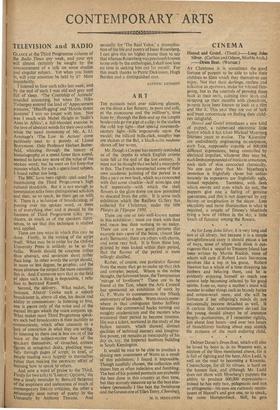THE parasols twirl over sidelong glances, on the divan a
fan flutters; in punt and cafe,
at the racecourse and the milliner's, time lazes by; through the Bois and up the Imola boulevards go the gigs at a clip; in the studios the cold top light—that special nineteenth- century light—falls impassively upon the model; the billiard balls click, naughty legs are shaken at the Bal, a black-satin madame shows off her wares.
Mr. Douglas Cooper has recently reminded us of the depths to which English artistic taste fell at the end of the last century. It must not be thought that we held a monopoly in this. The French resurrected some of their own academic painting of the period in a film a year or two back, which was concocted with that same chuckle—half nostalgia and half superiority—with which the shell flowers in the glass dome are now permitted to descend from the attic. It is some such exhibition which the Redfern Gallery has collected for Christmas, under the title Plaisirs de I'Epoque 1900.
There are one or two well-known names in this exhibition ; most are thick with dust and mean less than nothing to us today.
There are one or two good pictures (for example two views of the Seine, almost like early Bermans); there are others with charm, and some very bad. It is from these last, painted by men locked within their period, that the flavour of the period is most tellingly distilled.
Rather, of course, one particular flavour from the many that go to make up that rich and complex period. Where is the noble thought, the furrowed brow, the Tennysonian 'mirage of loveliness'? These are to be found at the Tate, where the Arts Council has sponsored an exhibition of work by G. F. Watts to commemorate the fiftieth anniversary of his death. Watts stands some- where in that ambiguous limbo halfway between the commercial hacks turning out naughty academicism and the masters who transcend their period to become timeless. His was a talent, nurtured in the study of the Italian masters, which showed distinct qualities of technical mastery and imagina- tive power, yet remains as inescapably of his day as, say, the Imperial Institute building in South Kensington.
It would be nice to be able to produce a shining new assessment of Watts as a result of this exhibition; I found it impossible. Though carefully chosen, the collection still shows him as often indecisive and fumbling. The best of his painted portraits are probably the best done in this country at that time, but they scarcely measure up to the best else- where (personally I like best the Swinburne and the famous one of Ellen Terry, Choosing);
• M. H. MIDDLETON


























 Previous page
Previous page